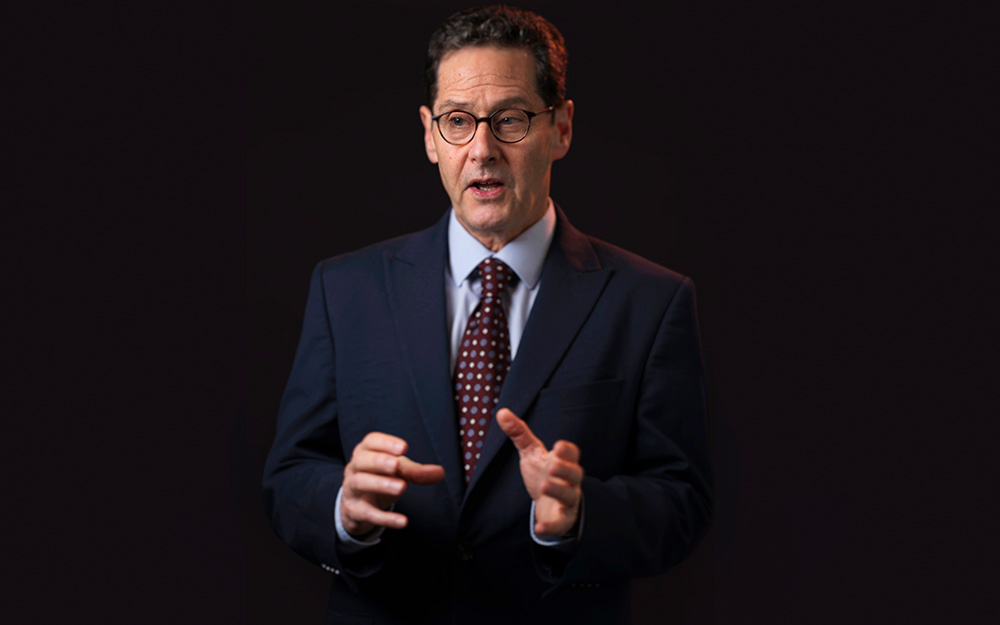Discoveries
A Map of Disease Beginnings
Apr 09, 2025 Victoria Pelham. Photo: Al Cuizon

Cedars-Sinai’s pediatric investigators are scrutinizing the earliest origins of disease in a bid for faster detection and more precisely tailored therapies. Using multiple omics tools, they will map young patients’ unique genetics and cell biology as early as the neonatal period. The initiative aims to foreshadow future health and sets the stage for a sweeping paradigm shift: Insights into disease trajectories could yield novel tools to diagnose and, ultimately, prevent diseases that strike at every age.
At the helm of the effort is David Rowitch, MD, PhD, associate director of Basic and Translational Research at Cedars-Sinai Guerin Children’s. His groundbreaking research in glial cell development in the brain has improved early diagnoses of neurological diseases and genetic risks. In a trial he co-led in England, whole-genome sequencing in more than 500 seriously ill infants resulted in diagnoses for one-third of them, one-fifth of whom would otherwise have gone undiagnosed.
Rowitch will lead an expert team across genetics, genomics, regenerative pediatric medicine, molecular biology, maternal-fetal medicine and neurodevelopment in targeting the most life-threatening and disabling conditions affecting pediatric patients.
“These children urgently need answers,” he emphasized in a discussion with Discoveries introducing the predictive model, reproduced below.
The Predictome Project could redefine pediatric care. What are your first steps?
We will begin by performing whole-genome sequencing in children who have serious medical problems. We are focusing first on the neonatal and pediatric intensive care units, since these patients are much more likely to have a genetic condition. In young epilepsy patients, in particular, genome sequencing has an approximately 50% probability of discovering a genetic basis.
We have recruited 20 Cedars-Sinai families to participate in an upcoming feasibility study, which will sequence both patients’ and their parents’ DNA, allowing for comparison to determine if faulty genes are inherited.
Approximately 25 to 30 million people in the U.S., including more than 3 million in California, have a rare disorder. In 80% of patients, it is caused by underlying genetics. A patient’s genome can serve as a treatment manual, pinpointing opportunities for gene therapies or identifying medications that could dramatically improve drug response and reduce treatment resistance.
Genomic sequencing could provide an effective diagnostic tool not only for health conditions but also for future risks. Why is this change in perspective so crucial?
We generally practice reactive medicine in the U.S., but by the time a problem is recognized, it may be past the point of optimal treatment. The promise of anticipatory testing is to face a health problem sooner, instead of waiting for it to strike.
Genetic conditions can present in utero or infancy. Genetics can be helpful in deciphering complex medical presentations we see in young children. While cerebral palsy has long been considered to be the result of brain damage around the time of birth, recent studies show that about 10% to 30% of this population may have an underlying genetic condition. Such information can illuminate a child’s course and offer new opportunities for precision therapies. We will be launching a cerebral palsy project at Cedars-Sinai precisely to investigate these issues.
Other conditions, such as cardiovascular disease, can develop in children and young people but remain largely asymptomatic—and undiagnosed—until middle age. Classic studies documented coronary and aortic fatty streaks and fibrous plaque in youth, and some are predisposed due to familial hypercholesterolemia, a hereditary condition linked to early heart attacks. We want to screen for those children to intervene earlier, for example, with statins.
Too commonly, a child is diagnosed with Type 1 diabetes only after presenting to the emergency room or ICU comatose, which can be fatal. What if we could predict that child’s vulnerability ahead of time? We would monitor them more carefully and treat them sooner with insulin, so they would never need hospitalization. By preventing an emergency, we’ve massively changed the trajectory for that child.
How will this approach seek to uncover the precise origins of health conditions?
Over the ensuing decades, Cedars-Sinai researchers will collect consented patients’ genetic information and track their health and medications. The effort will relate real-world outcomes to genetic clues. Ultimately, this information will refine our ability to understand the genome and make it a better predictive tool. By adulthood, physicians could manage care to delay or prevent physical and mental health conditions, the majority of which present by age 25.
In tandem with the Cedars-Sinai Board of Governors Innovation Center, we are also using a full range of omics techniques to study patient proteomes, transcriptomes, metabolomes and microbiomes. This could inform future predictive markers for renal, cardiovascular and metabolic diseases along with many other conditions.
A core value of this project will be delivering direct benefits to patients, using the latest medical insights, including new treatments such as gene- and cell-based therapy.
What is your vision for the next year?
Through the creation of the new Guerin Children’s Genetics Research Center and Early Detection Program, led by Mustafa Khokha, MD, and Saquib Lakhani, MD, and the Center for Developmental Biology and Regenerative Pediatrics under David Traver, PhD, we are building our capacity. Guerin Children's Executive Director Ophir Klein, MD, PhD, an expert in pediatric medical genetics, is overseeing this work to build the pediatrics of the future.
We are laying the groundwork first to diagnose genetic conditions in seriously ill children and then to implement screening protocols across the full age range of patients cared for by Cedars-Sinai.
I’m not expecting this preventive-medicine metamorphosis to take 20 years; we anticipate our team making genetic diagnoses and changing care within the year.



